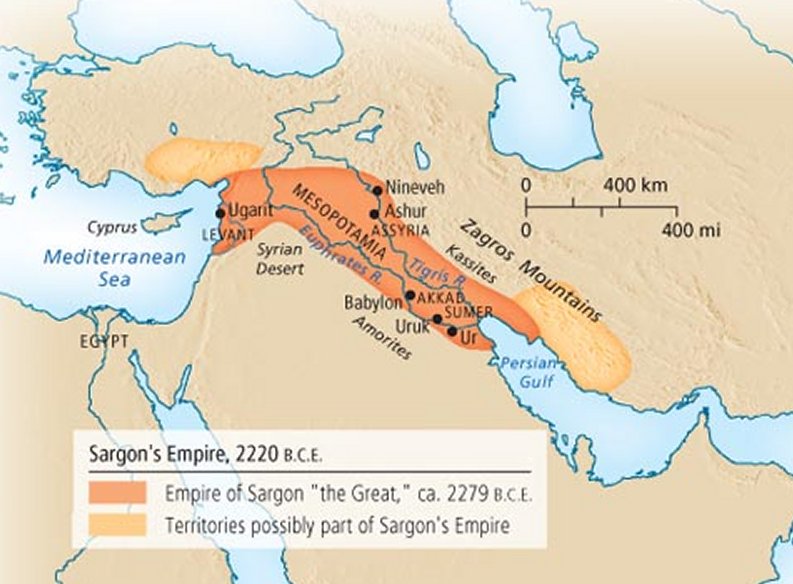Sargon Of Akkad – Prominent Leader Who Rose Out Of Obscurity
David Tee - AncientPages.com - Even though his true name, Sarru-kinnu, meant ‘true king’, he took the name Sargon when he ascended the throne. Why he did this is unknown and some scholars say it was a biblical translation, not a will full choice.
This name has given scholars the idea that Sargon the Great was a Semite who spoke a Semitic language.
The problem is that the name Sargon was used often after his reign confusing historians as to which legend, myth, or actual historical record applied to the original Sargon, known as the Great.
He Was Found Floating In A River
Legend has it that a gardener found Sargon floating in a river in a tiny little basket. This myth reflects the story of the biblical Moses and has led some scholars to claim that the biblical authors copied from Sargon’s birth to give Moses a more human and humble beginning.
Little is known of Sargon’s parents. His mother was supposed to be a priestess in an unknown town located around the middle of the Euphrates. His father is completely unknown. Even with the handicap of not knowing who his relatives were Sargon, rose to be the cupbearer of a ruler of Kish and because of this position, Sargon was given leadership over an army.
Sargon went on to conquer and create his powerful empire, establishing his name as Sargon the Great.
Historical Record And Tablets From Sargon’s Era
Finding information about Sargon is quite difficult. There are many men who came after him who used the same name. But the royal inscriptions do attest to him although the majority of Akkad texts come from 2nd millennium Assyrian and Babylonian texts.
Yet those were not the only locations that held inscriptions referring to Sargon. When the town of Ebla was unearthed, its importance was not fully realized. But Italian archaeologists decided to dig a little deeper and eventually came upon a much older city underneath Ebla.
In the ruins of that older city were 42 tablets from Sargon’s era. A little later 15,000 more were found and they detailed the business dealings and trade between different nations and Sargon. However, these documents do not pinpoint the dates of his rule nor provide a sequence to the events surrounding his life.
These tablets also described the law code that Sargon had imposed on his people. Men were fined for having sexual relations with unmarried women or if they were a virgin, they were put on trial to see if the woman was raped. Religious tablets were also found depicting the religious practices of the time.
He Expanded His Empire
Sargon was able to use his military and personal genius to carve out a large empire. After conquering Sumer, he set his sights on Syria, Susa of the Elamites, Southern Anatolia, and even western Iran.
For Sargon, keeping control of such a vast empire was not that difficult. He used trusted men to oversee the captive cities and regions, even to the point of using his daughter to make sure the conquered people were controlled through religious and political means.
No emperor has an easy time ruling other nations. The nation people have a way of becoming disgruntled with foreign rule and seek ways to end it. Even after reigning for 56 years, Sargon still had rebellions and other opposition to his rule to put down.
The fact that Sargon was able to create a dynasty and have a grandson named Sargon II shows that he was a capable ruler whose empire lasted long after his death. His influence also lasted long after his death as well.
Origin Of The Akkadian Language
Sumer’s language was quite different from the language that Sargon spoke. Akkadian was a Semite language which was only one version of a group of Semite languages that existed at that time.
The name Semite was taken from the Bible. It refers back to Shem, one of the sons of Noah. Some of the other Semitic languages spoken at that time and centuries afterward, are Hebrew, Arabic, Assyrian, and Babylonian.
Sargon The Great’s Legacy
While Sargon was a great leader, his empire did not last very long. He built a beautiful capital city and named it Agade. Unfortunately, this city did not survive past his grandson, Naram-Sin. The mountain living Guti descended upon Sargon’s capital city and destroyed.
But his capital city was not the only part of Sargon’s legacy. Two Assyrian kings were named after him. Sargon also left behind the law and religious code that helped govern his empire. Finally, his Agade city name evolved into Babylon which became a center point of Mesopotamia history for approx. 2,000 years
Even though Sargon the Great rose out of obscurity, he was able to grow into a great leader. He did not let his lack of family or status in life hinders him from obtaining the absolute leadership of the Akkadian people.
This is probably one reason he was given the title “the Great” when others examined his rise to power and his overall accomplishments. Sargon did not let handicaps or obstacles get in the way of his goals.
Sargon is credited with establishing the first world empire even though it may have been founded on earlier expansion efforts conducted by Lugalzagesi of Umma. No matter who started the expansion, it was Sargon who finished it. His influence helped guide future military leaders including Alexander the Great.
Written by – David Tee AncientPages.com Staff Writer
Copyright © AncientPages.com All rights reserved. This material may not be published, broadcast, rewritten or redistributed in whole or part without the express written permission of AncientPages.com
Expand for referencesReferences:
Youngblood, R. F., Bruce, F. F., & Harrison, R. K., Thomas Nelson Publishers (Eds.). (1995). In Nelson’s new illustrated Bible dictionary. Nashville, TN: Thomas Nelson, Inc.
Saggs, H.W.F. Babylonians
Roux, G. Ancient Iraq
From Syria Sensational New Collection of Tablets Found (1976). Bible and Spade, 5(3), 83.
More From Ancient Pages
-
 Bayeux Tapestry: Original Location Of Remarkable Romanesque Art – Finally Solved
Archaeology | Oct 26, 2019
Bayeux Tapestry: Original Location Of Remarkable Romanesque Art – Finally Solved
Archaeology | Oct 26, 2019 -
 Beethoven’s Genome Offers Clues To Composer’s Health And Family History
DNA | Mar 27, 2023
Beethoven’s Genome Offers Clues To Composer’s Health And Family History
DNA | Mar 27, 2023 -
 Indus Civilization And Complex Patterns Of Urbanity – New Study
Archaeology | Feb 21, 2022
Indus Civilization And Complex Patterns Of Urbanity – New Study
Archaeology | Feb 21, 2022 -
 Will-o’-the-wisp: Eerie Lights Over Swamps And Marshes That Frightened And Led People Astray
Featured Stories | Apr 23, 2020
Will-o’-the-wisp: Eerie Lights Over Swamps And Marshes That Frightened And Led People Astray
Featured Stories | Apr 23, 2020 -
 Ancient Settlement Inhabited By Urartian People – Unearthed
Archaeology | Oct 13, 2020
Ancient Settlement Inhabited By Urartian People – Unearthed
Archaeology | Oct 13, 2020 -
 The Spread Of Weighing Systems Across Western Eurasia 4,000 Years Ago
Archaeology | Jun 30, 2021
The Spread Of Weighing Systems Across Western Eurasia 4,000 Years Ago
Archaeology | Jun 30, 2021 -
 Kuthodaw Pagoda – ‘The World’s Largest Book’ Carved In 729 Marble Slabs
Featured Stories | Feb 24, 2018
Kuthodaw Pagoda – ‘The World’s Largest Book’ Carved In 729 Marble Slabs
Featured Stories | Feb 24, 2018 -
 Nottingham Scientists Investigate An Ancient Boat Buried Under A Pub Car Park
Archaeology | Feb 15, 2023
Nottingham Scientists Investigate An Ancient Boat Buried Under A Pub Car Park
Archaeology | Feb 15, 2023 -
 2500-Year-Old Objects Made From Goat Bones Discovered In Turkey’s City Of Aigai
Archaeology | Sep 17, 2020
2500-Year-Old Objects Made From Goat Bones Discovered In Turkey’s City Of Aigai
Archaeology | Sep 17, 2020 -
 World’s Oldest And Largest Maya Structure Revealed By LIDAR
Archaeology | Jun 9, 2020
World’s Oldest And Largest Maya Structure Revealed By LIDAR
Archaeology | Jun 9, 2020 -
 Aluminum Was Used At Least 7,000 Years Ago – Long Before The Metal’s Official Invention In 1825
Ancient Technology | Jul 10, 2017
Aluminum Was Used At Least 7,000 Years Ago – Long Before The Metal’s Official Invention In 1825
Ancient Technology | Jul 10, 2017 -
 King Khufu’s 4,600-Year-Old Solar Boat Has Been Transported To The Grand Egyptian Museum
Archaeology | Aug 9, 2021
King Khufu’s 4,600-Year-Old Solar Boat Has Been Transported To The Grand Egyptian Museum
Archaeology | Aug 9, 2021 -
 Ancient Ingapirca: Largest And Best Preserved Inca Ruins In Ecuador
Civilizations | Dec 9, 2016
Ancient Ingapirca: Largest And Best Preserved Inca Ruins In Ecuador
Civilizations | Dec 9, 2016 -
 Fascinating Ancient And Unexplained Mysteries Of Arizona – Strange, Unknown Creatures, Baffling Vanishings And Anomalies – Part 2
Featured Stories | Oct 1, 2024
Fascinating Ancient And Unexplained Mysteries Of Arizona – Strange, Unknown Creatures, Baffling Vanishings And Anomalies – Part 2
Featured Stories | Oct 1, 2024 -
 Mysterious Sumerian Statues With Big Blue Eyes – A Sign From The Gods
Civilizations | Feb 23, 2017
Mysterious Sumerian Statues With Big Blue Eyes – A Sign From The Gods
Civilizations | Feb 23, 2017 -
 On This Day In History: Precious Rosetta Stone Found By Napoleonic Expedition To Egypt – On July 15, 1799
News | Jul 15, 2016
On This Day In History: Precious Rosetta Stone Found By Napoleonic Expedition To Egypt – On July 15, 1799
News | Jul 15, 2016 -
 The City Of David – Why Is It So Controversial?
Biblical Mysteries | Jan 9, 2019
The City Of David – Why Is It So Controversial?
Biblical Mysteries | Jan 9, 2019 -
 Has Yorkshire’s Lost Underwater Town Ravenser Odd Finally Been Found?
News | Mar 26, 2022
Has Yorkshire’s Lost Underwater Town Ravenser Odd Finally Been Found?
News | Mar 26, 2022 -
 Mystery Of The Second Gabriel Stone And The Man Resurrected By Archangel Gabriel
Biblical Mysteries | Sep 10, 2018
Mystery Of The Second Gabriel Stone And The Man Resurrected By Archangel Gabriel
Biblical Mysteries | Sep 10, 2018 -
 Parachute May Have Been Invented By Ancient Chinese – Not Leonardo Da Vinci
Featured Stories | Dec 14, 2018
Parachute May Have Been Invented By Ancient Chinese – Not Leonardo Da Vinci
Featured Stories | Dec 14, 2018


